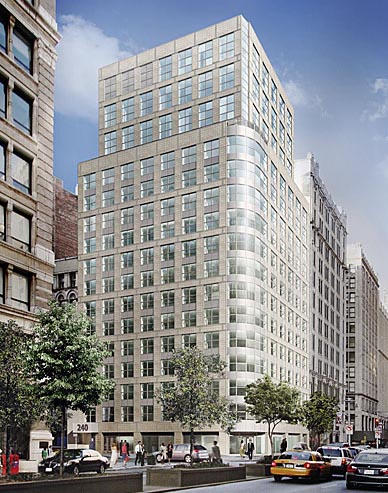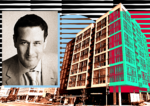Trending
240 Park Avenue South doesn’t rise to the level of other Gwathmey projects
The architects at Gwathmey Siegel & Associates Architects have many talents, but historicism, or contextualism if you prefer, is not one of them. And so the recently completed 240 Park Avenue South at 19th Street, is rather less interesting than some of the other works by this firm, whose principal, Charles Gwathmey, is best known for his late modernist style.
Certainly the new 17-story, mixed-used building has stylistic affinities with Gwathmey’s other completed works in New York, like the Science, Industry, and Business Library at Madison Avenue and 34th Street, the soon-to-be completed Soho Mews at 311 West Broadway, the Solomon R. Guggenheim Museum Annex, behind the museum at 1071 Fifth Avenue at 89th Street, that was completed in 1992, and above all, the much debated Astor Place Tower at 445 Lafayette Street.
Similarities to this last building are visible in the loving care with which the unadorned northwest corner of 240 Park Avenue South has been rounded, suggesting certain beloved modernist precedents, as well as the way in which its four-story setback crowns the 13-story base. Both structures, like most of Gwathmey’s works, favor a gray cladding — in The Metal On Astor Place and the stone at 240 Park Avenue South. But while the gray at Astor Place Tower achieves a certain vibrancy and sheen that accords well with the building’s machine aesthetic, the façade on Park Avenue South, with its punched windows and horizontal coursing lines every two floors, merely looks sad under the pale winter sun.

240 Park Avenue South
Clearly Gwathmey and his firm were gamely rising to the unwelcome task of bringing the new project into some kind of harmony with the dominant pre-war building stock that defines this weary stretch of Manhattan. And in that they have succeeded well enough. Indeed, they may have succeeded too well, in the sense that their new building falls in with its octogenarian neighbors and at no point dares to challenge them or add a jolt of energy to the avenue.
At the same time, the overall effect of 240 Park Avenue South is further compromised by a whiff of value engineering, of cost-cutting, that lends an air of makeshift insubstantiality to the exterior. And it doesn’t help that the architect has chosen to shift to white glass cladding at the rounded corner of the building, a refinement that was nowhere suggested in the initial renderings, and that contrasts with the silvery effect that was promised for the building as a whole.
James Gardner, formerly the architecture critic of the New York Sun, writes on the visual arts for several publications.




